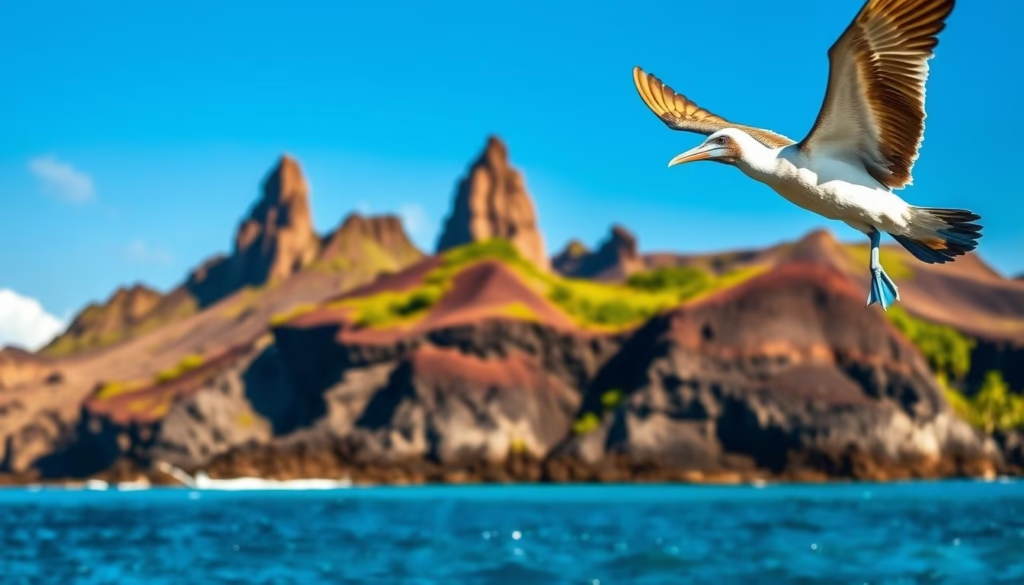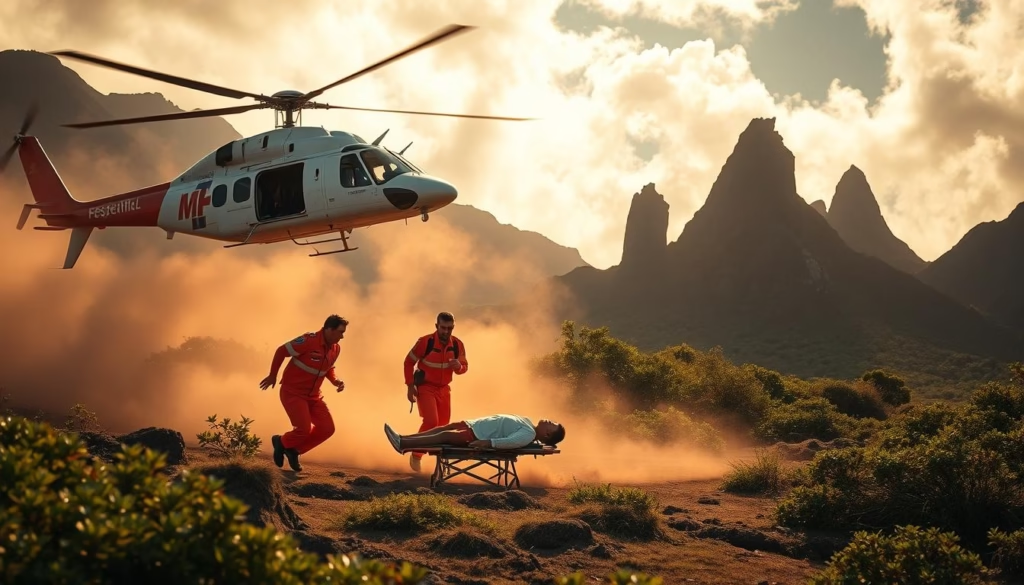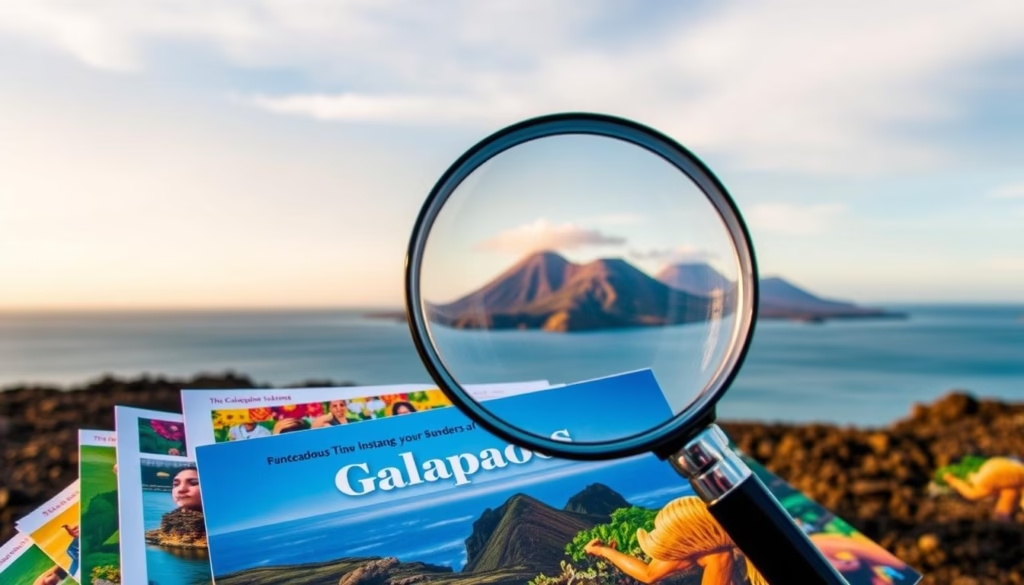What would you do if a sudden emergency forced an evacuation from a remote island and your plans, and costs, fell apart in a single day?
Galapagos travel insurance matters because the destination is remote and medical facilities are limited. Evacuations can cost tens of thousands and take time to arrange. This guide sets clear expectations so you know what coverage matters for an international trip.
We’ll compare emergency medical, evacuation, trip cancellation and interruption, baggage, AD&D, and travel delay benefits. Expect practical advice on CFAR options and how costs shift when you add adventure-sport coverage. We name real plans, like Allianz OneTrip Prime/Premier, to show options and limits.
Buy the right plan at the right time so you protect prepaid cruise fares and your overall experience. This introduction previews how to get quotes, what details to gather, and how to match coverage to your itinerary, whether you sail, stay in hotels, or island-hop.
Key Takeaways
- Why Travel Insurance Matters for a Remote Galapagos Trip
- Galapagos Travel Insurance Coverage Essentials
- Comparing Travel Insurance Companies and Brokers
- Costs, Pricing, and How to Save on Galapagos Insurance
- Plan Types and Adventure Activity Coverage for the Galapagos
- galapagos travel insurance: Get Quotes and Buy the Right Policy
- Conclusion
- FAQ
- Remote medical limits make emergency evacuation a major cost risk.
- Compare plans for evacuation, medical, cancellation, and delay coverage.
- Look for CFAR options if you need flexible cancellation protection.
- Gather itinerary details to get accurate quotes fast.
- High cruise costs and strict refund rules increase the value of a good plan.
- Buy soon after booking to maximize coverage from purchase through travel day.
Why Travel Insurance Matters for a Remote Galapagos Trip
When medical facilities are limited and flights are sparse, a single emergency can upend an entire itinerary.
Remote islands have a high-risk profile: routine problems become complex fast. The U.S. Department of State warns that a medical evacuation from the islands can top $60,000 and may take significant time to arrange. Local hospitals exist, but they lack capacity for major procedures.
A strong policy should prioritize emergency medical care and evacuation. Serious cases often require transfer to mainland Ecuador or onward to the U.S. That makes medical evacuation the focal benefit for most tourists.

Think about real scenarios: a sudden illness, an injury on a shore landing, or a missed flight that causes you to miss a cruise departure. Emergency benefits, medical evacuation, and delay coverage work together to handle costs and logistics.
Covered delay benefits can pay for hotels, meals, and re-routing so you can rejoin your ship and save valuable time on the islands. Keep documentation—doctor’s notes and airline delay statements—to speed claims.
Assess your health needs and risk tolerance before you buy. Compare limits and add medical evacuation where needed, and review Ecuador policy options for specifics on coverage and exclusions.
Galapagos Travel Insurance Coverage Essentials
Prioritizing robust emergency and evacuation limits is the single best step to protect a remote‑island itinerary.
Emergency medical care and medical evacuation should top your checklist. Evacuations from the islands can exceed $60,000, and local hospitals cannot handle major procedures. Choose an insurance policy that lists covered medical expenses, per‑incident caps, and whether the insurer pays providers directly or reimburses you.

Trip cancellation and CFAR options
Standard trip cancellation covers documented illness, injury, severe weather, or carrier problems. For more flexibility, add Cancel For Any Reason (CFAR) if available.
CFAR is usually an upgrade and time‑sensitive. It often reimburses a percentage (commonly up to 80%) of nonrefundable expenses when standard reasons do not apply.
Delays, missed cruise departures, baggage and AD&D
Travel delay benefits pay for extra hotel nights, meals, and new transport after a covered delay so you can catch a missed cruise. Check hourly minimums and per‑day caps.
Baggage loss or delay and AD&D are useful for lost gear or serious injury. Review typical limits and required documentation and consider higher limits if you carry expensive equipment.
- Confirm pre‑existing condition waiver windows and buy within the required days after the initial trip payment.
- Compare per‑day and per‑trip caps line by line to avoid claim surprises.
Comparing Travel Insurance Companies and Brokers
Start with a marketplace that shows multiple policies so you can spot coverage gaps fast. Use a broker to view quotes side‑by‑side and focus on meaningful differences, not just price.
Where to get quotes in the United States and beyond
U.S. travelers can quickly source multiple quotes via TravelInsurance.com to compare limits and add‑ons. Global travelers often use World Nomads for flexible international travel options and activity coverage.
Reading the fine print: covered reasons, exclusions, and policy limits
Carefully review covered reasons, exclusions, and sub‑limits. Look for medical evacuation caps, definitions of “reasonable and customary” charges, and pre‑existing condition rules.
| Source | Best for | Key benefit |
|---|---|---|
| TravelInsurance.com | U.S. multi‑company quotes | Fast side‑by‑side comparisons |
| World Nomads | Independent and adventure trips | Flexible policies for international travel |
| Direct carrier sites | Policy details and claims | Full contract and company support |
- Create a shortlist of two to three plans, then compare the fine print back‑to‑back.
- Check customer service reputation, claims response, and financial strength, not just the premium.
Costs, Pricing, and How to Save on Galapagos Insurance
Costs vary widely, so knowing what drives a premium helps you pick the right plan without surprises.
What affects the premium:
- Destination remoteness and perceived risk — remote islands push prices higher.
- Total trip cost and length in days — more prepaid expenses and longer stays raise premiums.
- Age and count of travelers — older or multiple travelers increase rates.
- Add‑ons like CFAR or adventure riders — these boost price but add flexibility.

Ways to reduce cost without skimping on key benefits
Choose a higher deductible to lower your premium, but know it raises out‑of‑pocket expenses if you claim.
Bundle policies when possible or buy a single trip plan instead of annual plans if you travel infrequently.
Buy within required windows to qualify for pre‑existing condition waivers or CFAR—timing can save money and add value.
Real-world pricing and decision tips
For example, a 30‑year‑old on a two‑week South America trip might pay about $225 with a high deductible, or roughly $350 for a $100 deductible.
Compare quotes with and without CFAR to see whether the extra cost is worth the flexibility for a trip that may cost thousands.
Check card benefits as a supplement, but don’t rely on them for major needs like evacuation.
Bottom line: align benefit limits with trip cost and risk tolerance rather than chasing the cheapest premium. Confirm per‑person and per‑trip caps and whether coverage is primary or secondary to avoid surprises when expenses mount.
Plan Types and Adventure Activity Coverage for the Galapagos
Picking the right plan hinges on how many trips you take and the types of activities you’ll do ashore and at sea.
Single-trip vs. annual plans
Single-trip policies (for example, Allianz OneTrip Prime/Premier) suit one international voyage and often have higher per-trip limits tailored to that itinerary.
Annual plans like AllTrips Premier cover multiple trips over 365 days and can save frequent travelers time and money.
Diving, snorkeling, trekking and other activities
Providers often list specific activities as higher risk. Deep diving, high‑altitude trekking, or unguided kayaking may need an activity rider or a higher plan tier to be covered.
Confirm whether equipment loss and guided vs. unguided status affect claims. Some policies require certifications for scuba to pay medical costs after a dive accident.
Cruises, tours and hotel stays
Liveaboard cruises add connection risk. Strong delay and interruption benefits help you rejoin a ship if flights or ferries run late.
Hotel-based itineraries and day tours reduce some logistics hurdles, but evacuation and hospital limits remain crucial for this remote destination.
| Plan Type | Best for | Key note |
|---|---|---|
| Single‑trip (OneTrip) | One international trip | Higher per‑trip limits; select activity riders as needed |
| Annual (AllTrips Premier) | Multiple trips in 12 months | Cost‑effective for frequent travelers; watch per‑trip caps |
| Activity rider | Diving, trekking, high‑risk sports | Adds coverage for specified pursuits; may require proof/certification |
Practical tips: Match plan benefits to your exact way of exploring—multi‑island cruise, guided day tours, or DIY hotel stays. Verify whether the policy is primary or secondary, confirm 24/7 assistance, and compare baggage limits if you bring dive or photo gear.
For a quick comparison of recommended options and how they handle activity coverage, see this guide on galapagos travel insurance.
galapagos travel insurance: Get Quotes and Buy the Right Policy
A quick, accurate quote begins with clear facts about who’s going and what you’ve already paid for.
Information you’ll need for an accurate quote
Collect these items before you start so quotes reflect real costs and risks.
- Total trip cost and breakdown of prepaid nonrefundable items.
- Exact travel dates, flight segments, and final payment due date.
- Ages of all travelers and the date of your first deposit.
- Any planned high‑risk activities or add‑ons like diving or trekking.
When to buy: securing coverage from booking to departure day
Buy soon after your initial payment to unlock time‑sensitive benefits.
Why timing matters: many insurers require purchase within a set window to qualify for CFAR or a pre‑existing condition waiver. This preserves trip cancellation flexibility and medical protections.
U.S. buyers can compare multiple quotes quickly at TravelInsurance.com; global buyers may consider World Nomads for flexible international options. Compare quotes the same day to keep variables consistent, then save or email summaries for review.
Before purchase, check that evacuation and medical caps match your trip value and risk. Verify flight connection timing and consider enhanced delay or interruption coverage if tight connections could risk missing a cruise or critical departure.
Final checklist: read the declarations page, set calendar reminders for benefit windows, and carry printed policy and assistance contacts on travel day. For more destination details and insurer comparisons, see this Ecuador guide on Ecuador policy options.
Conclusion
A well-chosen policy turns an unexpected medical event into a manageable expense, not a trip‑ending disaster.
Hospitals are limited on remote islands and evacuations can cost tens of thousands. That means robust medical and evacuation benefits should top your list.
Good coverage protects the money you’ve committed to cruises, tours, and nonrefundable bookings. Compare policies from multiple companies and match plan limits to your activities and logistics.
Even healthy, active travelers can face illness, injury, or severe delay. For trips worth thousands, the extra premium is often a small price for 24/7 assistance and peace of mind.
Do this now: gather trip details, get same‑day quotes, read the fine print, and buy in time to lock in key benefits. For more on destination requirements and medical risks, see is it safe to travel the.
FAQ
What does Galapagos travel insurance typically cover?
A good policy covers emergency medical care, medical evacuation off the islands, trip cancellation and interruption (including Cancel For Any Reason upgrades), travel delays, missed cruise departures, baggage loss, and accidental death & dismemberment. Look for policies that include coverage for excursions, boat tours, and hotel expenses tied to itinerary disruptions.
Do I really need evacuation coverage for a remote island trip?
Yes. Medical facilities on the islands are limited. Evacuation can require air transport to mainland hospitals and costs can reach tens of thousands of dollars. A policy with robust medical evacuation and repatriation limits protects you from high out‑of‑pocket expenses and ensures timely care.
When should I buy a policy to maximize protection?
Buy as soon as you book nonrefundable flights, tours, or cruises. Early purchase often qualifies you for pre‑existing condition waivers and full cancellation benefits. Some plans offer coverage from the day of booking through departure, while others must be purchased within a short window to get certain protections.
How do trip cancellation and CFAR options differ?
Standard trip cancellation reimburses only for covered reasons listed in the policy, such as illness, severe weather, or jury duty. Cancel For Any Reason (CFAR) lets you cancel for other reasons and recover a percentage of prepaid, nonrefundable costs—usually 50–75%—if you buy CFAR within a specific timeframe and follow policy rules.
Are adventure activities like snorkeling and diving covered?
Coverage varies. Many plans cover common activities like guided snorkeling and trekking, but scuba diving often requires an adventure or hazardous‑sports rider. Verify activity definitions, depth limits, certification requirements, and whether injuries during boat excursions or wildlife encounters are included.
How do I choose between single‑trip and annual plans?
Choose a single‑trip policy for one defined itinerary. Pick an annual multi‑trip plan if you take several international trips in a year and want continuous coverage for shorter stays. Compare limits for emergency medical, evacuation, and trip interruption to ensure each trip’s costs are protected.
Where can I get reliable quotes in the United States and internationally?
Use major insurers and brokers such as Allianz, World Nomads, IMG, Seven Corners, and Travel Guard, plus comparison sites and licensed brokers. For U.S. residents, check company sites and broker platforms for real‑time quotes, benefits summaries, and customer reviews. International travelers should use providers licensed in their home country.
What information do I need to get an accurate quote?
Provide traveler ages, trip dates, total prepaid trip costs, destinations, planned activities (diving, cruises, trekking), existing medical conditions, and any prepayment receipts. Accurate details ensure correct premiums and help determine if you qualify for pre‑existing condition waivers.
How does trip length, destination, and number of travelers affect cost?
Premiums rise with longer trips, higher trip cost, and older travelers. Remote destinations and adventure activities increase risk and cost. Adding family members or multiple travelers can raise premiums but often offers group discounts through some plans.
What are smart ways to lower my premium without sacrificing key benefits?
Raise your deductible, remove CFAR if you don’t need it, bundle coverage through the same insurer, and buy early to access lower rates. Compare limits and exclude redundant coverages you already have (like baggage on a credit card) to reduce cost while keeping essential medical and evacuation benefits.
How do I read the fine print and spot exclusions?
Check covered reasons, policy limits, sublimits for evacuation and medical care, activity exclusions, and exclusions related to pre‑existing conditions. Look for exclusions for hazardous behavior, alcohol or drug use, epidemics, and certain natural disasters. Confirm claim filing deadlines and required documentation.
Will a policy cover missed cruise departures or itinerary changes?
Many plans reimburse reasonable expenses for missed cruise departures, rebooking fees, and additional hotel nights caused by covered delays. Confirm limits and requirements—some policies require documentation from carriers and receipts for extra expenses to process claims.
Are baggage loss and delays covered for specialized gear like dive equipment or camera equipment?
Baggage coverage usually applies, but high‑value items often have per‑item limits. Buy higher limits or a rider for expensive dive gear, cameras, and electronics. Keep receipts and an itemized list to support claims, and report losses promptly to carriers and local authorities.
How quickly are claims for medical emergencies and evacuations handled?
Reputable companies provide 24/7 emergency assistance hotlines that coordinate care and evacuations immediately. Timely contact speeds approvals and reduces personal liability. Keep the insurer’s emergency number handy and follow their instructions for referrals and hospital admissions.
Does travel insurance cover illness or event cancellations due to pandemics or government advisories?
Coverage for pandemics and government advisories varies by carrier and policy date. Some plans include limited coverage for COVID‑19 illness; others exclude advisories or require a specific endorsement. Read policy language on epidemics, quarantines, and government travel warnings before buying.
Can I buy coverage for a cruise that includes island stops and shore excursions?
Yes. Choose a plan that explicitly covers cruises and shore excursions. Ensure policies cover missed cruise connections, onboard medical treatment limits, and evacuation from remote stops. Confirm how trip interruption works if an excursion provider cancels or an illness prevents boarding.
What should I do if I need to cancel for a reason not listed in the policy?
Without CFAR, claims for nonlisted reasons usually deny. To limit losses, keep documentation and explore refund policies with tour operators, airlines, and hotels. Consider travel credit cards with trip delay or cancellation benefits as a backup.
How do deductibles and benefit limits affect out‑of‑pocket costs?
Higher deductibles lower premiums but increase what you pay before benefits kick in. Benefit limits cap reimbursements per category (medical, evacuation, baggage). Choose a deductible and limits that match your financial comfort and the potential costs of emergency evacuation and medical care.
Are pre‑existing medical conditions covered?
Many plans exclude pre‑existing conditions unless you meet waiver requirements—typically purchasing within a time window after initial trip payment and insuring full trip cost. Review definitions of stability periods and required medical disclosures to determine eligibility.
How do I file a claim after an incident abroad?
Collect medical reports, police reports, receipts, proof of payment, and travel documents. Contact your insurer’s claims department promptly, complete claim forms, and submit requested records. Keep copies and follow up regularly until resolution.
Where can I find reputable reviews and customer service ratings for insurers?
Check the Better Business Bureau, Trustpilot, ConsumerAffairs, and independent travel forums. Look for reviews focused on claims handling, response times, and emergency assistance coordination. Ratings from A.M. Best and financial strength indicators can also help evaluate stability.